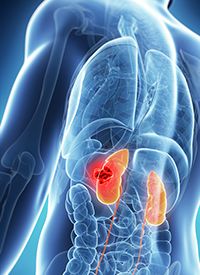Article
Expert Shares Insight on Biomarker Development in RCC
Author(s):
Kerstin Junker, MD, PhD, discusses the need to identify prognostic biomarkers for patients with RCC.

Identifying prognostic biomarkers remains a vital area of study in renal cell carcinoma, according to Kerstin Junker, MD, PhD, who adds that it is important to recognize the various subtypes of RCC when making individualized treatment decisions for patients.
The most common subtypes of RCC include clear cell RCC, which makes up 70% to 75% of patients, followed by papillary RCC, chromophobe, and benign oncocytomes. Each subtype represents a distinct tumor entity with a different tumor biology, making it necessary to develop biomarkers that can predict patient outcomes, she added.
OncLive: What are some key things to note about subtyping RCC?
In an interview with OncLive, Junker, associate professor, Department of Urology, Universität des Saarlandes, and chair of the European Association of Urology Section of Urological Research, discussed the need to identify prognostic biomarkers for patients with RCC.Junker: In RCC, there are different subtypes of the disease, not just one. Therefore, it is important to understand that we have different entities that have different biology, prognosis, and outcomes. The first thing that we should do is look at each subtype separately and investigate biological approaches in order to find targets for therapy and identify biomarkers that can predict outcomes.
Clear cell RCC is the most frequent [subtype]. In addition, there is a high rate of metastases in about 50% of patients. Those who develop distant metastasis have a poor prognosis. What we need is to predict the risk of development of metastasis. This will define individual patients who might benefit from adjuvant therapy.
Currently, we have classical prognostic markers based on scoring systems that can define groups of patients. However, it is not enough, as we need to pick patients with a high risk of metastases.
We have several good prognostic markers that can better predict which patients have a risk of metastasis based on molecular changes in the primary tumor. I will present data on the chromosomal level and the gene expression level. We could also develop a signature, which can predict the risk of development of distant metastases.
Physicians need to learn that we have good markers now. We should not use single markers because metastasis is a complex process and a single marker cannot be relied upon, so we have to use multiple signatures. However, we need to validate these markers in clinical practice. We also need to start clinical trials, as we are doing for treatments, to prove these markers and signatures.
Are there clinical trials investigating markers or does this remain an unmet need?
What is the next step in terms of research?
Currently, this is a gap in patient care because oncologists are saying that we do not have good markers, which is not true. However, we have to step forward and prove them in trials.There are not many clinical trials that are investigating this. I would say there are no movements to test markers. It is a problem. If you want to introduce a new therapy, there are companies that can finance these trials. However, if you want to introduce a marker, then there is no interest from most companies; therefore, we need another form of financing. It is important research, but there are not very good standards for testing markers. As I said, it is difficult to find sponsorship for those trials. In Germany, we have official organizations that can provide that financing, so we are working on developing those trials.We have to prove the benefit of these prognostic biomarkers. This is the first step. Several studies are investigating adjuvant therapies. Some trials have shown that there is no effect for using tyrosine kinase inhibitors, but we would like to test the effectiveness when we use these molecular prognostic markers. Then, if you could identify patients who are high risk, you might be able to see more of a difference. That is one way that we can improve.
We could also make improvements in clinical trials. In the future of adjuvant trials, such markers should be used to see if there is an advantage in a certain selection of patients and the effect of these therapies. However, we have to do prospective testing of the markers and signatures that we currently have.
Is there anything else you would like to add?
In addition, we are also looking at the tumors. We want to identify changes that can predict the risk based on the tumor, but there is also a tumor microenvironment that influences the development of metastases. We need to conduct more research of metastases to better understand how these tumor cells can change. For example, we need to understand specific alterations that are necessary in specific organs to understand why RCC metastasis is rising—mainly in the lung, brain, and bones. We should learn that the communication between tumor cells and microenvironment also plays an important role when developing new therapeutic strategies.It is important for everyone to work together, particularly the researchers and the oncologists. When researchers understand the clinical problems that will lead to better research. When the physicians understand more about the biological basics of tumor development, we can treat patients better. We could go further and faster in this field to bring new markers and develop new therapeutic strategies based on what we understand from tumor biology.
Latest Conference Coverage

Durvalumab Plus Vaccine Therapy Elicits ‘Encouraging’ DFS in BCG-Unresponsive NMIBC

Iparomlimab/Tuvonralimab Plus Chemo ± Bevacizumab Yields Responses in Recurrent/Metastatic Cervical Cancer

BMS-986253 Plus Nivolumab/Ipilimumab Fails to Boost Responses in Advanced Melanoma After Prior Anti–PD-(L)1 Therapy

Tremelimumab Plus Paclitaxel Generates Responses in Refractory Metastatic Urothelial Cancer
2 Commerce Drive
Cranbury, NJ 08512





